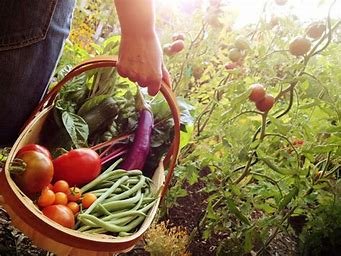Growing your own organic garden is a rewarding and sustainable way to enjoy fresh, healthy food while reducing your environmental footprint. Organic gardening avoids the use of synthetic chemicals, fertilizers, and pesticides, promoting biodiversity and soil health. Whether you’re a beginner or looking to refine your gardening skills.

1. Plan Your Garden
Choose the Right Location
- Sunlight: Most vegetables and herbs need at least 6–8 hours of direct sunlight each day. Choose a sunny spot in your yard or balcony that gets enough light.
- Soil: Check the quality of your soil. Organic gardening relies on healthy soil, so avoid areas with compacted or poor soil. If you’re gardening in containers, choose high-quality, organic potting mix.
- Water: Ensure that your garden area has good drainage and access to water. Avoid areas where water may pool or stand, as this can lead to root rot.
Select What to Grow
- Climate and Season: Choose plants that are suited to your climate and growing season. Consider whether your region has a long or short growing season, and plan accordingly.
- Vegetables and Herbs: Start with easy-to-grow crops like tomatoes, lettuce, spinach, carrots, cucumbers, peppers, and herbs such as basil, parsley, and cilantro.
- Companion Planting: Some plants grow better when placed next to each other. For example, planting basil next to tomatoes can improve flavor and deter pests.
- Consider Space: If you have limited space, consider growing vertically (using trellises) or in containers. You can even grow herbs in small pots on windowsills.
2. Prepare the Soil
Test Your Soil
- Soil Test: To understand the pH, nutrient levels, and overall health of your soil, consider doing a simple soil test. You can buy a soil testing kit or send a sample to a local agricultural extension service.
- Amend Your Soil: Based on the test results, you may need to add organic amendments such as compost, well-rotted manure, or cover crops. These materials will improve soil structure, fertility, and moisture retention.
Improve Soil Health
- Compost: Make your own compost from kitchen scraps, yard waste, and organic materials. Compost helps enrich the soil with nutrients and improves its texture.
- Mulching: Apply organic mulch (straw, wood chips, grass clippings) to your garden beds to retain moisture, regulate soil temperature, and suppress weeds.
- Avoid Chemical Fertilizers: Organic gardening avoids synthetic fertilizers. Instead, rely on natural fertilizers such as compost, aged manure, or organic soil amendments like bone meal, blood meal, or fish emulsion.
3. Planting Your Garden
Start Seeds Indoors (Optional)
- Timing: Start seeds indoors 6–8 weeks before the last frost date for your area. This is especially important for long-growing season crops like tomatoes, peppers, and eggplants.
- Containers: Use seed trays or small pots filled with organic seed-starting mix. Make sure your containers have drainage holes.
- Light and Temperature: Place the seedlings in a sunny window or under grow lights, and keep the temperature warm (around 65–75°F or 18–24°C) until they’re ready to be transplanted outdoors.
Direct Seeding Outdoors
- Plant at the Right Time: Once the danger of frost has passed, plant seeds directly into the ground. Follow seed packet instructions for proper depth and spacing.
- Spacing: Avoid overcrowding plants by giving them enough room to grow. This reduces competition for nutrients and light, and improves airflow, reducing the risk of disease.
4. Watering and Maintenance
Watering Your Garden
- Consistent Watering: Keep the soil evenly moist but not soggy. Water deeply and less frequently, rather than shallow watering, to encourage deep root growth.
- Morning Watering: Water your garden in the early morning to avoid fungal diseases, as this allows time for the soil and leaves to dry out before evening.
- Water Conservation: Use techniques like drip irrigation, soaker hoses, or rain barrels to conserve water and ensure that water reaches the plant roots rather than evaporating from the surface.
Weeding
- Weed Regularly: Weeds compete with your plants for nutrients and space. Remove weeds by hand or with a hoe regularly to prevent them from taking over your garden.
- Mulch to Prevent Weeds: As mentioned earlier, mulch helps keep weeds down while also retaining moisture and enriching the soil.
5. Natural Pest and Disease Control
Encourage Beneficial Insects
- Attract Pollinators: Plant flowers like sunflowers, lavender, and marigolds to attract pollinators like bees and butterflies.
- Beneficial Insects: Ladybugs, predatory beetles, and lacewings help control pests such as aphids, mealybugs, and spider mites. You can purchase these insects or encourage them by planting a variety of flowers and herbs.
Use Natural Remedies
- Neem Oil: Neem oil is an organic pesticide that is effective in controlling a variety of pests. It works by disrupting the pests’ hormonal systems and preventing them from feeding and reproducing.
- Diatomaceous Earth: This is a natural, non-toxic powder that can be sprinkled around plants to control crawling insects like ants, slugs, and aphids.
- Companion Plants: Some plants naturally repel pests. For example, garlic and chives can help keep aphids and pests away from your vegetable plants.
Prevent Disease
- Good Airflow: Space plants far enough apart to allow good airflow, reducing the risk of fungal diseases.
- Crop Rotation: Rotate crops each year to prevent soil depletion and reduce the spread of disease.
- Clean Tools: Regularly clean your gardening tools to prevent the spread of disease.
6. Harvesting and Enjoying Your Garden
Harvest at the Right Time
- Know When to Harvest: Each vegetable has a specific time when it’s ready to be harvested. For example, tomatoes are ripe when they’re fully colored and slightly soft to the touch, while leafy greens can be harvested when they’re young and tender.
- Harvest Regularly: Harvesting regularly encourages more growth and can prevent your plants from becoming overripe and attracting pests.
Preserving Your Harvest
- Canning: If you have a large harvest, consider canning or preserving fruits and vegetables for later use.
- Freezing: Many vegetables can be frozen for later use, such as peas, corn, and berries. Ensure they’re blanched properly before freezing to retain nutrients and flavor.
7. Keep Learning and Improving
Gardening is an ongoing process of learning and adapting. As you grow your garden, take notes on what worked and what didn’t. Over time, you’ll gain more knowledge about your garden’s needs and how to improve it.
- Research: Keep reading books, watching tutorials, and following gardening blogs for tips on how to better manage your organic garden.
- Join a Community: Connect with local gardening groups, community gardens, or online forums for support, advice, and inspiration.
Conclusion
Growing your own organic garden is an enriching and sustainable practice that can benefit both your health and the environment. By focusing on healthy soil, natural pest control, and organic growing methods, you can create a bountiful garden while reducing your environmental impact. Start small, plan wisely, and enjoy the process of nurturing your plants from seed to harvest!
